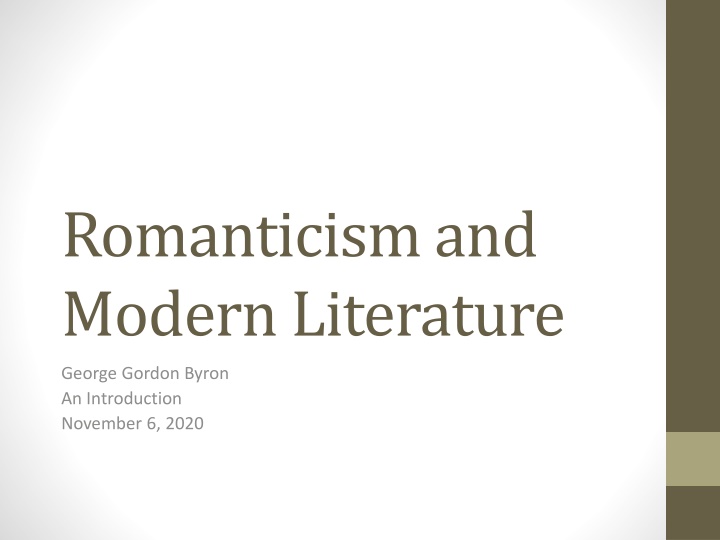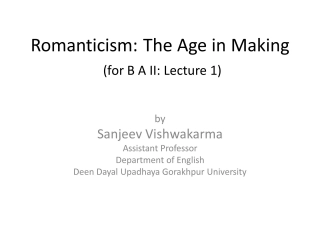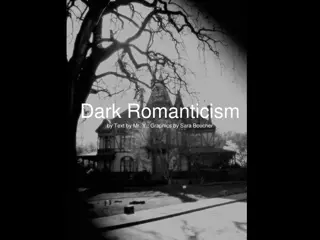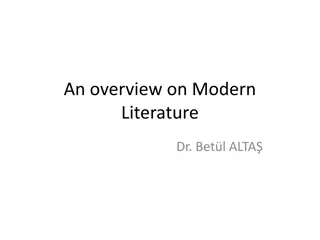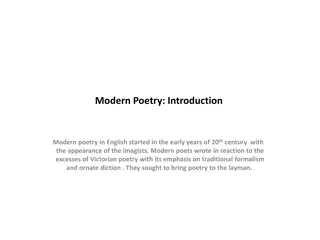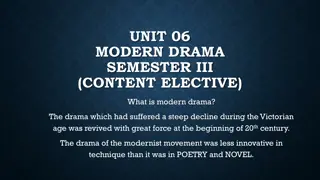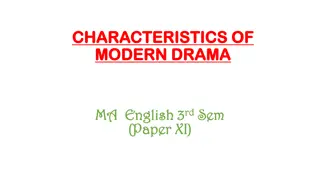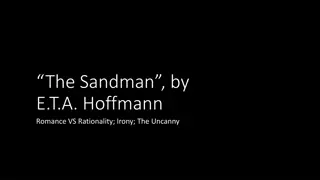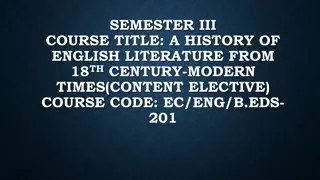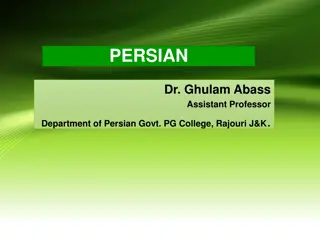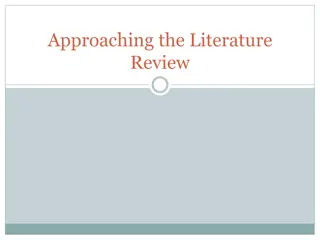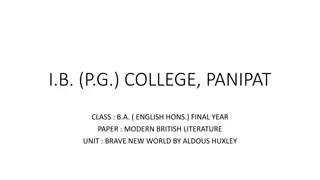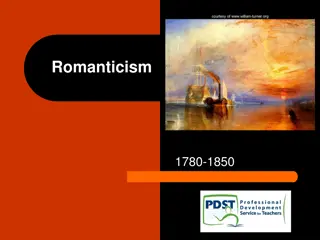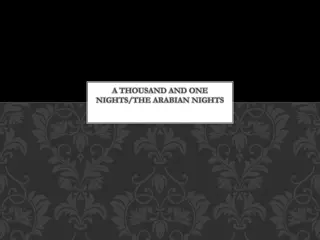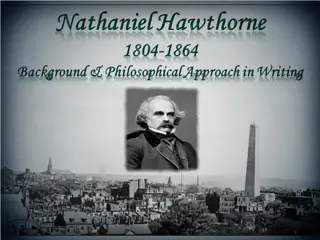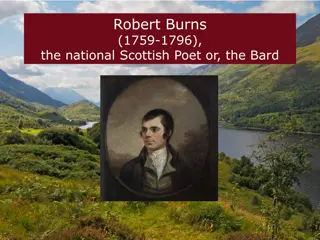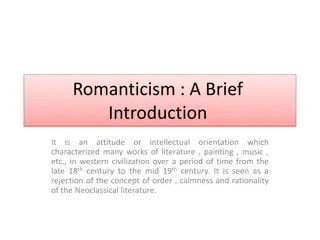Romanticism and Modern Literature
Lord George Gordon Byron, a prominent English poet born in 1788, faced personal challenges from a young age. Despite his family's financial struggles, Byron showed early signs of literary talent and a complex personal life. Explore his journey from childhood to adulthood, navigating love, education, and societal expectations.
Download Presentation

Please find below an Image/Link to download the presentation.
The content on the website is provided AS IS for your information and personal use only. It may not be sold, licensed, or shared on other websites without obtaining consent from the author.If you encounter any issues during the download, it is possible that the publisher has removed the file from their server.
You are allowed to download the files provided on this website for personal or commercial use, subject to the condition that they are used lawfully. All files are the property of their respective owners.
The content on the website is provided AS IS for your information and personal use only. It may not be sold, licensed, or shared on other websites without obtaining consent from the author.
E N D
Presentation Transcript
Romanticism and Modern Literature George Gordon Byron An Introduction November 6, 2020
Born with a club-foot Lord George Gordon Byron (1788-1824), English poet, was born on 22 January 1788, the son of the nephew of the fifth Baron Byron of Rochdale, Captain John 'Mad Jack' Byron, and his second wife, Catherine Gordon of Gight, an impoverished Scots heiress. George Byron was born with a caul, a transparent birth sac shrouding the upper extremities of the newborn which was traditionally held to confer luck and immunity from drowning, and a club-foot.
Fathers death with debt In September 1790, having squandered his second wife's fortune, much as he did that of his first wife, Jack Byron deserted his wife and son in Aberdeen where the family had gone to live. On 2 August 1791, the debt-ridden Jack Byron died in France of tuberculosis, aged thirty-six, leaving her and her young son with the responsibility for paying off his debts. Byron's later words on his father were to prove portentous of Byron's own fate: 'He seemed born for his own ruin and that of the other sex.'
The title of the sixth Lord Byron In late summer 1794, on the death of his father's nephew, Byron became heir presumptive to the title and estates of the fifth Lord Byron, at the age of six and a half. In May 1798, the 'Wicked' fifth Lord Byron died, and Byron, aged nine, became the sixth Baron Byron of Rochdale. Byron's mother was landed with 'Wicked' Lord Byron's debts, which she duly settled, to the further impoverishment of herself and her son. In 1798, Byron and his mother returned to England, and Byron's ramshackle family inheritance of Newstead Abbey, in Nottinghamshire. A valuable property, the estate was nonetheless burdened with debt.
Falling in love from the age of 12 In 1799, Byron was sent to Dr Glennie's preparatory school in Dulwich. In 1800, Byron fell in love with his first cousin, Margaret Parker, and in 1803, with Mary Chaworth of nearby Annesley Hall. In 1804, Byron began an intimate correspondence with his half-sister Augusta, whom he had probably met for the first time in 1802. His increasing bond with his sister coincided with a growing distance between himself and his mother who now stigmatised Byron with being his father's son.
Harrow and Cambridge From 1801 to 1805, Byron attended Harrow school, and from October 1805 until July 1808 Trinity College, Cambridge. Despite having attended, by the end of his course, scarcely three of the nine terms of residence required, and worried that consequently he would not receive his degree, Byron was awarded his M.A. from Cambridge. A lifelong friendship with John Cam Hobhouse, who stirred his interest in liberal Whiggism. In March 1809, having attained his majority, Byron took his seat as a Whig in the House of Lords.
Travelling Europe Byron left England with Hobhouse for a tour of the Mediterranean in 1808. Between 1809 and 1811, Byron visited Portugal, Spain, Malta, Greece, Albania, and Turkey. Byron arrived back in England in July 1811, to suffer a devastating series of bereavements. On 1 August 1811, Byron's mother died, aged forty-six, of an unspecified illness, possibly, in view of rumours about her drunkenness. After a series of death of his friends, he was told that John Edleston, the former chorister of Trinity College, who had, as Byron remarked, been Byron's prot g and to whom Byron had been both father figure and lover, had died in May, aged twenty-one.
Childe Harolds Pilgrimage In October 1809, Byron began the long poem in Spenserian stanzas that was to make his literary reputation, Childe Harold's Pilgrimage (1812-18). The poem's first two cantos appeared in 1812, Canto III in 1816, and Canto IV, the final canto, in 1818. Childe Harold's Pilgrimage describes the travels and reflections of a pilgrim, Childe Harold, whose life and journeyings correspond to Byron's own. In Childe Harold's Pilgrimage, Byron teases his readers with suggestions of sex and blasphemy. Childe Harold himself is no innocent, rather 'Childe' is an archaic title denoting the scion of a noble house.
Byrons liberal politics In 1812, Byron resumed his seat in the House of Lords. In February, against the proposed Frame Work Bill which was directed at rioting Nottinghamshire weavers and which sought to make the destruction of machinery punishable by death. In April, Byron spoke in favour of Catholic Emancipation.
'mad-bad-and dangerous to know' Having affairs with a series of ladies such as Lady Caroline Lamb, Lady Jane Scott Oxford. Having affairs with his half-sister, Augusta leaving Elizabeth Medora, supposedly his daughter. In The Bride of Abydos: A Turkish Tale (1813), dealing with incest based on his own experience.
Marriage On 2 January 1815, having been again rejected by her during the previous year, Byron married Annabella Milbanke in a private ceremony at Seaham where she lived. At the time, the new Lady Byron ominously remarked: 'If I am not happy, it will be my own fault.' The couple passed their 'treacle-moon' at nearby Halnaby Hall, during which Byron woke at night believing himself, according to Washington Irving, to be dead and damned, 'fairly in hell with Proserpine lying beside me!'
Daughter born and divorce On 10 December 1815, Byron's and Annabella's daughter, Augusta Ada, was born, as Byron smashed bottles in the room below. According to servants, Byron locked himself in with Annabella immediately after she had given birth, and attempted to rape her. Following the ensuing uproar and Byron's angry departure, in January 1816, Annabella Byron received a letter from her husband ordering both her and the four-week-old baby out of his house. Shortly afterwards, Annabella left London with her baby, to travel northwards to Seaham. Byron would never see either of them again. That year, Byron's wife asked for a legal separation to which he eventually agreed.
Leaving England In April 1816, Byron left England, in the company of Dr John William Polidori, an unsuitably humourless travelling companion. Byron was, as it transpired, never to return. The two travelled through Belgium and up the Rhine to Switzerland where they settled at Villa Diodati on Lake Geneva. There they spent the summer in the company of Percy Shelley, Mary Shelley , and Mary's stepsister Claire Clairmont, who had become pregnant by Byron in a brief encounter in London that March, and who was intent on pressing her claim on him. In January 1817, Claire gave birth to a daughter, Alba, or, as she became, Allegra, who was to die in April 1822. In November 1816, Byron settled in Venice where he began an affair with his landlady at Casa Segati, Marianna Segati.
Don Juan Part fictional autobiography, Byron's unfinished epic satire in ottava rima, Don Juan (1819-24), asserts the poet's emphatic mastery of the form. Canto II, in particular, manages to be funny, pathetic, and sad, its wide emotional range dramatically and movingly signalling Byron's mastery. Concerning a young man from Seville, Don Juan, and his affairs with the beautiful women he meets, the poem is a picaresque, literary burlesque, directed at social, sexual, and religious hypocrisies, and at sentimentality. Having been at first labelled 'filthy and impious', Don Juan gradually became successful. At first, Shelley was virtually alone in recognising Don Juan's worth, calling it the 'greatest long poem in English since Paradise Lost'; later he was plunged into despairing jealousy on hearing Byron read Canto V, remarking nonetheless that it was 'astonishingly fine'.
Shelleys Death On 13 July 1822, Shelley, Edward Ellerker Williams and their boatboy were drowned whilst sailing Shelley's boat the Don Juan. Byron, deciding that his anti-Christian friend should have a proper pagan ceremony for the cremation, had the bodies exhumed from the Protestant Cemetery in Rome where they had been buried, and cremated on the seashore on 15 August.
For Greece Byron had, however, never fully considered poetry to be his true, or at least his only, calling, and on 6 January 1824, determined to devote his efforts and prestige to the Greek struggle for independence, crossed to the besieged mainland town of Missolonghi. Prior to his departure, Byron had remarked to Marguerite Power, Lady Blessington: 'I have a presentiment I shall die in Greece.'
Death Leaving Missolonghi in February, with the aim of capturing the Turkish occupied fortress of Lepanto, Byron's health deteriorated and he caught a fever. Threatened with the loss of his sanity if he refused his doctors' request to bleed him, Byron acceded. Lord George Gordon Byron died on 19 April 1824. The immediate cause of his death probably being uraemia abetted by bleedings. His final words were 'Io lascio qualque cosa di caro nel mondo' -- I leave something dear to the world. Despite his deathbed request 'let not my body be hacked, or be sent to England', his body was interred in the vault of the Byron family church, St. Mary Magdalene, Hucknall Torkard, Nottinghamshire, on 16 July 1824.
